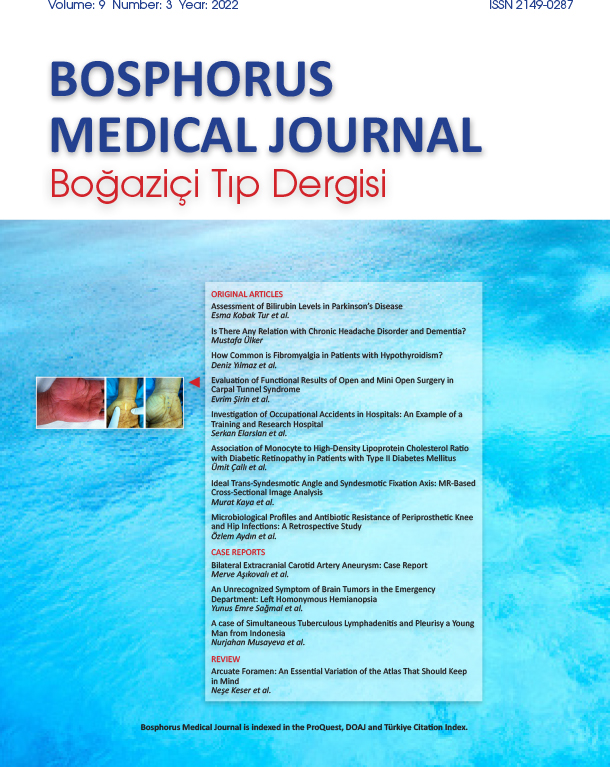Volume: 7 Issue: 3 - 2020
| ORIGINAL RESEARCH | |
| 1. | The Effects of Virtual Reality-based Wii Fit Yoga on Pain, Functionality and Trigger Points in Non-specific Chronic Low Back Pain Patients: A Randomized Controlled Trial Fatih Bağcıer, Sevilay Batıbay doi: 10.14744/bmj.2020.92486 Pages 75 - 81 INTRODUCTION: This study aims to investigate whether or not there was a difference in the efficacy of conventional exercise (CE) treatment and virtual reality (VR)-based Wii Fit yoga applications on the parameters of pain, functionality and myofascial trigger points (MTrP) in patients with non-specific chronic low back pain (nCLBP). METHODS: This study was conducted on a total of 34 patients separated into two groups as the Wii Fit Yoga group and the CE group. In the Wii Fit group, yoga was performed with the Nintendo Wii device for 45 mins, five days a week, for six weeks. The yoga poses included the half-moon, lunge, single-leg extension, torso-twist, tree, and warrior directed at the lower back area. For the CE group, a home exercise program was prescribed comprising stretching, strengthening and posture exercises to be performed at the same frequency and for the same duration as the yoga group. Pain, MTrP's and functionality parameters were evaluated before and after treatment. RESULTS: Following treatment, a statistically significant improvement was observed in all the pain scores, functionality parameters and algometer measurements compared to the baseline values in both groups (p<0.001). No statistically significant difference was determined between the groups. DISCUSSION AND CONCLUSION: The application of VR-based Wii Fit Yoga was effective on pain, functionality and MTrP in patients with nCLBP and should be considered as an alternative approach to CE treatment. There is a need for further studies on this subject with larger patient populations and a longer follow-up period. |
| 2. | Satisfaction of Patients and their Caregivers who Received Health Service at Home Özden Güdük, Özlem Güdük, Yaşar Sertbaş doi: 10.14744/bmj.2020.39200 Pages 82 - 88 INTRODUCTION: Measuring the users satisfaction is one of the crucial indicators used in the evaluation of quality in home health services. In this study, we aimed to measure the satisfaction of patients and their relatives who received home health care. METHODS: In this study, the satisfaction of the patients and their relatives receiving health care at home was measured using the Home Health Services Patient Experience Questionnaire. The questionnaire was applied to 375 people and the data obtained were analyzed using the SPSS (Statistical Package for Social Sciences for Windows 22) program. In the numerical comparison of the groups, the Mann-Whitney U test and Kruskal Wallis test were used. RESULTS: The findings showed that 84% of the participants stated that the services provided met their expectations. No statistically significant difference was found in the satisfaction level of the respondents according to the sex and education level of the respondents and the subject (patient/patient relatives) (p=0.109; p=0.089 and p=0.916, respectively). However, there was a significant difference in satisfaction level among age groups (p=0.038). The age group with the highest satisfaction was 50-59 years old and the group with the lowest was 49 years old and below. The majority of the participants (91%) stated that they could recommend the service to other people. DISCUSSION AND CONCLUSION: The findings obtained in this study suggest that the patients and their relatives are mostly satisfied with home healthcare. |
| 3. | Evaluation of focal Electroencephalography Findings in Idiopathic (Genetic) Generalized Epilepsy Işıl Kalyoncu Aslan, Günay Gül doi: 10.14744/bmj.2020.56198 Pages 89 - 95 INTRODUCTION: As a definition, idiopathic (genetic) generalized epilepsy (IGE) diagnostic criteria do not involve focal electroencephalography (EEG) anomalies, the patients have cranial imaging findings within normal limits and focal or lateralized seizures are absent. After long-term observations, it is shown that the EEG findings may include continuous and consistent focal anomalies. The present study aims to determine the clinical significance of focal EEG findings and to determine the relationship between these findings and structural lesions. METHODS: Forty-eight patients were selected according to IGE diagnostic criteria determined by International League against Epilepsy. These patients were interviewed concerning family and personal medical history. In the EEGs unilateral discharges, discharges that start unilaterally and generalize, and discharges that showed amplitude asymmetry, more than 50% were defined as focal findings. Cranial Magnetic Resonance Imaging (MRI) protocol for epilepsy was performed on all of the patients. RESULTS: Focal EEG findings were present in 54.2%; the highest ratio was in patients with juvenile myoclonic epilepsy. Focal findings in EEGs did not have any significant relationship with Cranial MRI abnormalities. The findings showed that 26 patients had focal findings at least one of three EEGs of 26 patients; five patients had abnormal cranial MRI findings; five patients had both focal EEG findings and abnormal cranial MRIs. DISCUSSION AND CONCLUSION: The ratio of focal findings was higher with 54.2%. However, in these patients, two out of three EEGs did not have any focal findings, and there was not any correlation between focal findings and any of the parameters. It was concluded that the focal findings in EEGs are not necessarily related to a cranial structural anomaly and the focal EEG findings should be persistent to be related to such anomalies. These focal disturbances may be related to the prognosis; however, further research is needed for a definite conclusion. |
| 4. | High Levels of HbA1C among Internal Medicine Inpatients and Relationship with Undiagnosed Diabetes Rates Elif Yıldırım Ayaz, Nalan Okuroğlu, Ali Özdemir doi: 10.14744/bmj.2020.75436 Pages 96 - 101 INTRODUCTION: Diabetes Mellitus (DM) is a significant cause of mortality and morbidity and may lead to microvascular and macrovascular complications. This can be prevented through early diagnosis of diabetes and achieving glycemic control. Measurement of the fasting glucose, random glucose, oral glucose tolerance test (OGTT) and HbA1C levels have been adopted in the diagnosis of diabetes. This study has searched for DM diagnosis rate using HbA1C measurements in the inpatient population. METHODS: This retrospective study included all inpatients whose HbA1C levels were measured at the Internal Diseases Clinic of Fatih Sultan Mehmet Training and Research Hospital in 2015. Glucose, blood urea nitrogen (BUN), creatinine, fasting glucose levels, age, gender and primary causes of admission of the patients were recorded. The patients, who had HbA1C value of 6.5 or more, were defined as newly diagnosed DM. Before this study, the patients were included in three groups as patients with a previous diabetes diagnosis, patients with a new diabetes diagnosis and patients with no diabetes diagnosis. RESULTS: Among 1057 patients included in this study, 29.7% had past diabetes diagnosis (Group 1), 7.5% were newly diagnosed diabetes, while 62.8% patients have no diabetes. No statistically significant difference was found concerning age and gender distribution. No significant difference was found between the HbA1C, fasting glucose and random glucose levels of Group 1 and Group 2. BUN levels of the patients in Group 3 were lower than those in Group 1. Creatinine levels of Group 1 were higher than in Group 3. No significant difference was identified concerning the duration of hospital stay and mortality between the groups. DISCUSSION AND CONCLUSION: New DM diagnosis rate was 7.5% among the patients admitted to the internal diseases clinic within a year. Besides, in the high-risk population of inpatients, the routine HbA1C measurement may lead to early diagnosis by increasing the undiagnosed patient rate. |
| CASE REPORT | |
| 5. | A Case of Congenital Chylous Ascites and Hypothyroidism: Coincidence or Association? Özgül Bulut, Emine Asuman Çoban, Zeynep Ince doi: 10.14744/bmj.2020.78941 Pages 102 - 105 Congenital chylous ascites (CA) is the rare accumulation of chyle in the peritoneal cavity, often occurring in infants under three months of age. In this case study, we report a case of congenital CA detected prenatally on routine 34-week fetal ultrasound in the presence of congenital hypothyroidism. Treatment consisting of thyroid hormone supplementation, a diet high in middle-chain triglycerides and octreotide administration was undertaken. To our knowledge, this is the second case of CA in the presence of congenital hypothyroidism described in the literature. |
| 6. | Thrombotic Thrombocytopenic Purpura Presenting with Headache and Agitation: Case Report Hatice Ferhan Kömürcü, Ezgi Yakupoğlu, Eren Gözke doi: 10.14744/bmj.2020.00710 Pages 106 - 108 Thrombotic thrombocytopenic purpura (TTP) is a rare disease affecting many systems. TTP may be associated with fever, thrombocytopenia, hemolytic anemia, kidney and neurological dysfunction. Central nervous system and kidneys are frequently affected by TTP. Neurological symptoms include headache, mental disturbance, and changes in consciousness, seizures and focal neurological deficits. In this case study, we present a patient who was admitted to the emergency department with headache and agitation and was diagnosed as TTP. |
| REVIEW | |
| 7. | Different Surgical Techniques on Internal Limiting Membrane for the Treatment of Idiopathic Macular Hole Meltem Güzin Altınel, Banu Açıkalın doi: 10.14744/bmj.2020.52824 Pages 109 - 115 Idiopathic macular hole is a vitreomacular interface disease and an anatomical and functional retinal pathology. Different treatment alternatives on the internal limiting membrane (ILM) in patients with an idiopathic macular hole (MH) result in a high MH closure rate and improvement in visual function. ILM is very transparent and thin, but the usage of new dyes and the development of microincision surgery improve both closure rate and visual recovery. |




















